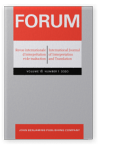Vol. 18:1 (2020) ► pp.68–85
The impact of translated Harry Potter on children’s fantasy literature system in South Korea
This study examined the impact of translated Harry Potter series on Korea’s literature system, adopting Even-Zohar’s polysystem theory. Literature review shows that (1) discourses on children’s fantasy literature increased; (2) the number of the country’s original children’s fantasy books apparently inspired by Harry Potter rose; (3) the country’s discourses about children’s fantasy literature began to focus more on its own originals and their distinctive features. This indicates that translated Harry Potter moved to the centre in Korea’s children’s literary system. And this is mainly attributed to the weakness of the country’s fantasy literature system. This research is based on Even-Zohar’s polysystem theory which is considered an effective framework to describe the dynamic and competitive interplay between systems, and it is significant as the first attempt to explain the rise of translated fantasy children’s books in Korea’s children’s literature system in the wake of the sweeping popularity of translated Harry Potter.
Article outline
- 1.Introduction
- 2.Discourses on children’s fantasy literature in South Korea
- 3.The impact of translated Harry Potter on South Korea’s children’s fantasy literature system
- 4.Changes in South Korea’s original children’s fantasy literature
- 5.Concluding remarks
- Notes
-
References
